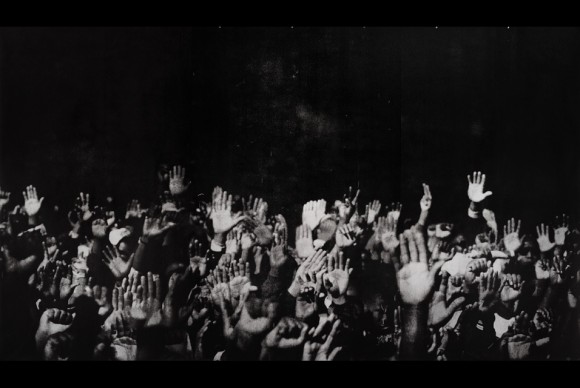The Whitney Presents a Mid-Career Retrospective of Groundbreaking New York Artist
March 11, 2011 by All Art News
Filed under Art Events & Exhibitions
NEW YORK. N.Y.- This spring, the Whitney Museum of American Art presents the first comprehensive mid-career retrospective of Glenn Ligon (b. 1960), widely regarded as one of the most important and influential American artists to have emerged in the past two decades. Organized by Whitney curator Scott Rothkopf, in close collaboration with the artist, the exhibition surveys twenty-five years of Ligon’s work, from his student days in the Whitney Independent Study Program until the present. The exhibition will travel to the Los Angeles County Museum of Art, where it will be on view from October 2011 to January 2012, and to the Modern Art Museum of Fort Worth, where it will appear early next year.
Glenn Ligon: AMERICA features roughly one hundred works, including paintings, prints, photography, drawings, and sculptural installations, as well as striking recent neon reliefs, one newly commissioned for the Whitney’s Madison Avenue windows. The retrospective also debuts previously unexhibited early works, which shed light on Ligon’s artistic origins, and for the first time reconstitutes major series, such as the seminal “Door” paintings, which launched the artist’s career. Loans are drawn from important institutional and private collections, as well as from the artist’s and the Whitney’s substantial holdings.
Adam D. Weinberg, the Museum’s Alice Pratt Brown Director, notes: “Few artists in the Whitney’s history have had as close a relationship with the Museum as Glenn Ligon has, dating back to his time in the Independent Study Program. Not only does the Whitney hold the largest institutional collection of his work, but Ligon has appeared in numerous exhibitions, including such landmark shows as the 1993 Whitney Biennial and Black Male in 1994. This retrospective honors Ligon’s remarkable artistic achievement and celebrates our long relationship with him.”
Throughout his career, Ligon has pursued an incisive exploration of American history, literature, and society in a body of work that builds critically on the legacies of modern painting and more recent conceptual art. A leading member of a generation of artists who came to the fore in the late 1980s and early 1990s by exploring racial and sexual identity in their work, Ligon is best known for his series of text-based paintings referencing the writings of noted African American authors such as Zora Neale Hurston and Ralph Ellison, as well as Jean Genet, John Howard Griffin, and Mary Shelley, among others. These iconic black-and-white paintings—with their play between abstraction and legibility, light and dark, disembodied text and painterly physicality—signaled the arrival of a singular artistic vision that synthesized questions of identity with key concerns from recent art history, such as the role of appropriation and language in art. Rothkopf remarks: “Although Ligon emerged in the wake of the American culture wars, with hindsight we are increasingly able to appreciate the formal subtlety and beauty of his work, which in fact add to its force and social relevance. The exhibition is titled Glenn Ligon: AMERICA to draw attention to the fact that he addresses the concerns of all Americans, regardless of our backgrounds, while exploring our sometimes troubled histories and shared dreams for the future.”
Ligon has dealt with a wide range of source material, which is highlighted in the Whitney exhibition. One gallery re-creates the bulk of his landmark multimedia installation To Disembark (1993), which explores the aftereffects of slavery in America through a series of prints in which Ligon casts himself as a slave on the lam and a group of crates playing music that allude to the story of Henry Box Brown, a slave who famously shipped himself to freedom. Another gallery features Notes on the Margin of the Black Book (1991–93), Ligon’s moving reflection on the cultural debates surrounding the photography of Robert Mapplethorpe; this stunning, fifty-foot-long piece remains a landmark of the art of the 1990s. A 1996 exhibition reflecting on Louis Farrakhan’s controversial Million Man March is reprised for the first time through a series of large-scale printed canvases and self-portraits of the artist in the manner of mug-shot photography. Also on display are eleven brightly colored paintings borrowing quotations from Richard Pryor’s stand-up routines, which are both funny and troubling in their frank social critique, and a group of six majestic canvases that treat quotations from James Baldwin’s essay “Stranger in the Village” in oil stick and glittering coal dust.
Other bodies of work employ images and texts related to early civil rights demonstrations, political figures such as Jesse Jackson and Malcolm X, and 1970s coloring books and “dream books” targeted at the African American community. The final dramatic gallery presents three twelve-foot-long neon works featuring the word AMERICA glowing beneath black paint. Although deeply pointed and courageous, Ligon’s artistic voice is more subtle than strident, more investigative than declarative, the breadth of his subject matter matched by the wide range of mediums he employs.

